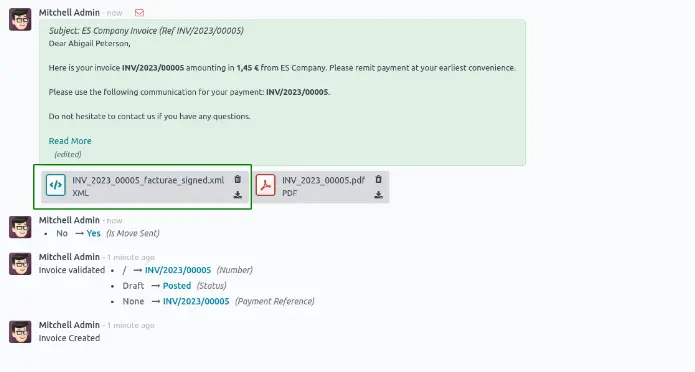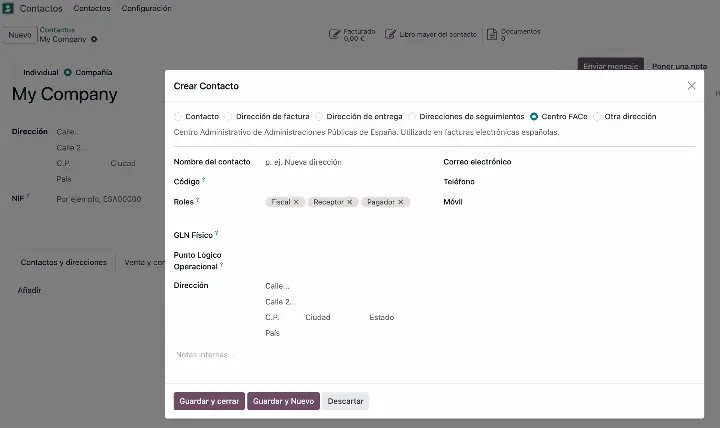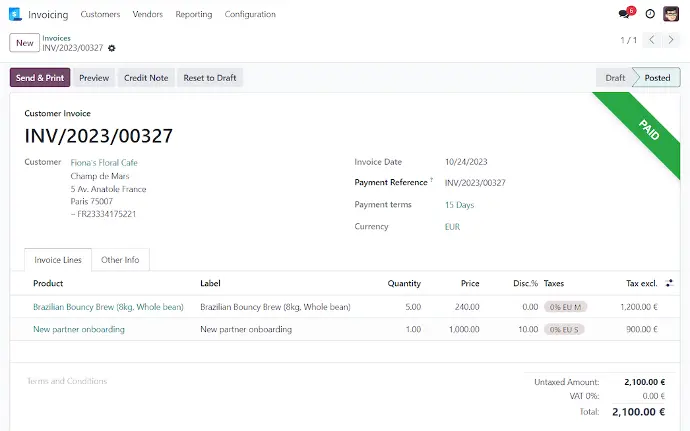Issue your electronic invoices with Odoo! Odoo already has the automatic issuance of electronic invoices in a fully integrated way in the system / with a total integration in the system. As simple as uploading your certificate, Odoo will take care of the rest.
What is the electronic invoice (E-Invoice)?
The electronic invoice is a way of issuing a regular invoice, but in xml format. In short, it is an alternative to the traditional paper invoice with the same level of validity.
We highlight the legal validity, since the electronic invoice is governed by the same Royal Decree (1619/2021, November 30) as the traditional invoice. In this line, Odoo complies with all the legal requirements that are reflected in it.
Among others, the regulations set forth in this law include:
- Obligation to issue the invoice
- Requirements: legible, authentic and complete.
- Deadlines
- Types: complete and simplified
- Other invoices: recapitulative, duplicate and rectifying.
Similarly, the electronic invoice issued by Odoo is in structured format (xml), which will allow the issued invoice to be processed by the accounting system of the receiver, as well as for their payment systems.
In the case of invoices in unstructured format, which consist of an image, will not cause any problem to manage them with Odoo. Usually, this format usually slows down the processes, however, thanks to the OCR included in Odoo, the system will scan the invoices and you will not have to enter them into the system manually.
Why this change?
Electronic invoicing has a number of advantages, including a lower probability of fraud, faster billing cycles, reduced costs and storage space and a lower environmental impact.
It is inevitable to find some disadvantages, such as the need for a system that allows you to generate this type of files, but the benefits are enough to tip the balance.
At Odoo we have always been committed to being a paperless company, not only for the optimization of resources but also for environmental responsibility. Thus, the system has been adapted to this format to facilitate access to electronic invoicing to any company or self-employed that requires electronic invoicing.
When will it be required?
The obligation to present invoices in electronic format will come with the approval of the Crea y Crece Law. Should it be published in 2024, companies whose annual turnover is greater than 8 million euros will have one year to implement the electronic invoice. In the case of invoicing less than 8 million, companies will have 2 years since the law becomes effective.
In the case of annual invoicing of less than 6 million euros, they will have a period of 4 years from the date the law comes into force. In other words, if the Crea y Crece Law comes into force in 2024, in this case, it will be effective in 2028.
How does it work in Odoo?
Issuing electronic invoices in Odoo will not involve any more clicks than if you were to generate your regular invoice. Once you have uploaded your digital signature certificate, thanks to the FacturaE module, the system will automatically create the invoice in xml format so you can issue it.
This format can be sent by email or Whatsapp directly from the system. In this way, you will not lose traceability, both the invoice in pdf and xml format will be saved in the system, with date and time of issuance, as well as the person responsible for it.
How to issue an electronic invoice from Odoo?
- Install the FACe module from Applications
- Install your certificate for electronic signature*
- Access the invoicing app
- Create the invoice with the necessary data (link to requirements for face within the text)
- Send the invoice and you will see both the pdf and the xml


Remember to download your xml file and access the official government website in order to send your invoice to Hacienda, luckily, this can be done in bulk.
*To install in Odoo 17 you must access your company's form and add the certificate. In Odoo 18 you must access the Configuration in the Accounting app and upload your certificate.
And in case of invoicing the public administration?
Sending electronic invoices to the public administration is already a reality in Odoo and it will be as simple as we have just seen.
In this case we will have only one additional step, in the recipient's contact form we must include the recipient's identifier:
- Managing body (Receiver)
- Processing unit (Payer)
- Accounting office (Fiscal)

What information is necessary to issue an electronic invoice?
- Identification data of both the issuer and the receiver, as well as their Tax ID numbers.
- Date of issue
- Date on which the services were rendered
- Description of the services or products rendered
- Taxable base
- Tax rate and the corresponding taxes
The recipient's consent will also be required in order to issue the electronic invoice.
What can we expect in the near future?
With regard to new developments in electronic invoicing, in order to streamline procedures, facilitate processes and reduce fraud, work is being done on the incorporation of a QR code to electronic and paper invoices. This code will inform the recipient of the invoice whether it has been sent to the Tax Authorities and whether the issuer is registered.
On the other hand, we have time to adapt, since this application will not be mandatory until 9 months after its approval.
From Odoo we are working every day on the next updates, not only our developers, but the whole community, proposing improvements to include in the following versions. This is why we are already working on improvements for electronic invoicing and to be always up to date with the legal requirements.
Discover Odoo's Invoicing App
¡El módulo de Facturación de Odoo es el proceso de facturación más sencillo que encontrarás!
Genere facturas de calidad, adáptelas a sus preferencias y reciba los pagos con prontitud.


